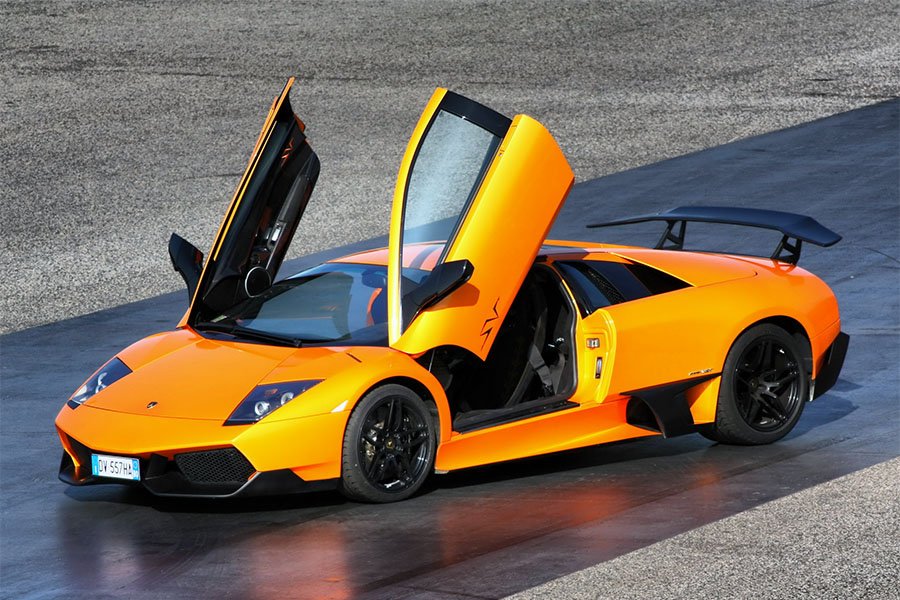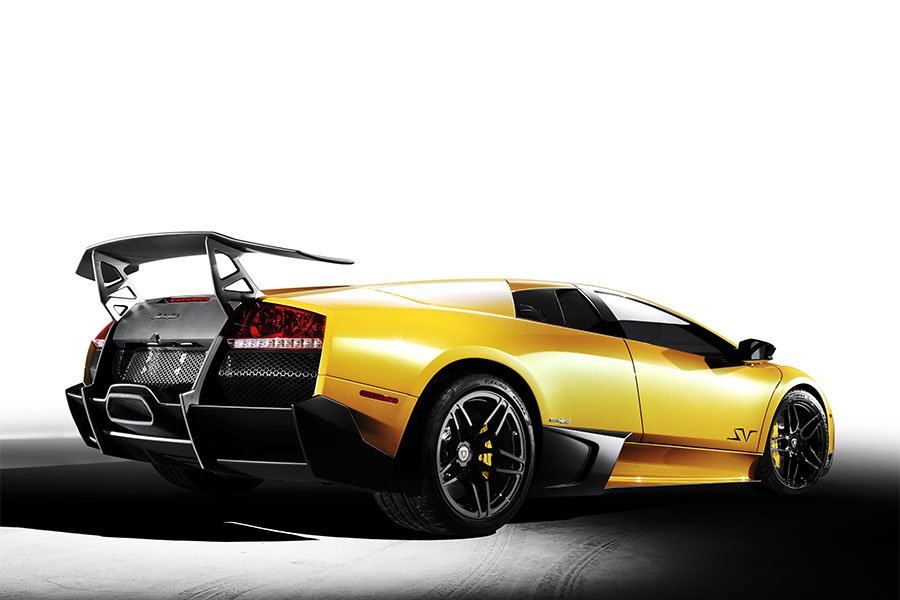Guide: Super Veloce - a Historical & Technical Appraisal of the Lamborghini Murcielago LP670-4 SV
/BACKGROUND
Within ten years of having taken over at Automobili Lamborghini, Audi had completely transformed the Italian company’s balance sheet. The last full year under the firm’s prior ownership (1997) had seen less than 200 cars leave the Sant’Agata factory whereas, by the late 2000s, Lamborghini was typically churning out over ten times that figure.
The flagship V12-powered Murcielago (introduced back in 2001) had proven a fitting replacement for the Diablo while the addition of a much-needed junior model, the Gallardo (introduced in 2003), had yielded sales hitherto unseen at Lamborghini.
Four-and-a-half years after the original Murcielago had made its debut (at Frankfurt in September 2001), an updated version was launched at the Los Angeles Motor Show in January 2006. The revamped LP640 featured a larger V12 engine (6.5-litres as opposed to 6.2), superior brakes, an exterior and interior face-lift, handsome new wheels and a variety of new optional extras.
A little over three years on, Lamborghini decided to introduce a range-topping run-out special that revived one of the firm’s most famous high performance monikers: SV.
Lamborghini had first used the SV tag for the final series production Miura produced between 1971 and ‘73. Back then, SV reputedly stood for Spinto Veloce (literally pushed fast) while on the subsequent Diablo SV (manufactured between 1995 and ‘99) it had meant Sport Veloce.
For this latest application ten years on the definition of SV was redefined again - it now stood for Super Veloce (super fast).
The LP670-4 SV was the most extreme road-going iteration of the Murcielago produced by Lamborghini and made its international debut at the Geneva Motor Show in March 2009.
Unlike the LP640 (which could also be ordered in Roadster trim), the SV was offered exclusively as a Coupe. It most notably came with a stiffer, lighter chassis, a 5% power boost, the normally optional carbon brakes and front axle lift as standard, new wheels and tyres, a revised aero kit, a simplified sports-tuned interior and 100kg of weight savings.
A limited run of 350 cars was expected to be built, after which an all-new replacement would take over.
The SV joined the existing LP640 in Lamborghini’s line-up plus of course the Gallardo which by this time was being offered in myriad different variations.
CHASSIS
As per previous iterations of the Murcielago, the SV was based on a tubular steel spaceframe reinforced with a carbonfibre honeycomb centre section and underbody. However, in order to save weight and increase torsional rigidity, new high-strength steel was used for the SV.
Suspension was identical to the LP640 with double wishbones, coil springs and electronic self-adjusting shock absorbers that offered both manual and automatic control. Anti-roll bars were fitted at either end and the SV came with front axle lift as standard.
Another optional extra on the LP640 that was fitted as standard to the SV was Carbonfibre-Reinforced Silicon Carbide brake discs. Whereas the base model ran cast-iron discs of 380mm front / 355mm rear with four-piston calipers all round, the carbon ceramic upgrade utilised 380mm discs with six-piston calipers for both axles.
Like the LP640, the SV came with 18-inch diameter wheels (8.5-inches wide front and 13 to the rear). Its new Ares design five twin-spoke forged alloys were SV exclusives and left the factory wrapped in Pirelli P Zero Corsa tyres.
The power-assisted steering was re-tuned for added high speed sensitivity.
As usual, a 100-litre fuel tank was located to the right of the engine, up against the rear bulkhead.
ENGINE / TRANSMISSION
Compared to the original Murcielago’s all-alloy DOHC 60° V12, the LP640 ’s engine had been taken from 6192cc to 6496cc. This was achieved by enlarging the cylinder bores by 1mm (from 88mm to 89mm) and extending the stroke by 2.2mm (from 86.8mm to 89mm).
In addition, the cylinder heads, variable intake system, crankshaft, camshafts and exhaust system were all updated. Dry-sump lubrication was retained along with Lamborghini’s own LIE fuel-injection system. Revised closed-loop electronic control units had improved the on-road performance and responsiveness of the engine.
For the SV, this existing arrangement was further uprated with optimised valve timing, a reworked intake system and a completely new lightweight exhaust.
An 11.0:1 compression ratio was retained.
The SV motor pumped out 661bhp at 8000rpm compared to 631bhp at the same engine speed for the LP640.
An identical 487lb-ft of torque was developed but it now came on stream 500rpm higher than before (6500rpm as opposed to 6000rpm).
Two types of six-speed gearbox was offered on the SV – the normally optional semi-automatic F1-style E-Gear was fitted as standard while a traditional manual ‘box was available as a no-cost option.
E-Gear offered a choice of fully automatic gear changes or manual shifts via paddles mounted on the steering column. One of three different drive modes could be specified: Normal (the default setting), Sport (which offered the fastest possible shift times) and Low Adherence (for adverse conditions). There was also a launch control system and traction control.
Transmission was through Lamborghini’s Viscous Traction permanent four-wheel drive system that comprised a rear differential integrated with the engine and a viscous coupling centre differential that transferred power to the front wheels. Torque distribution was normally 70% rear and 30% front. However, up to 100% of the drive could be applied to a single axle.
BODYWORK
Lamborghini fitted the SV with a revised aero kit in order to create substantially more downforce and improve high speed stability.
The brand new front apron featured an extended air-piercing upper element, under which were enlarged intakes and a large matt black carbonfibre chin spoiler.
Further up, cooling slots were carved out from atop the front fenders.
Down each flank were new gloss black mirrors and enlarged matt black asymmetrical intake scoops ahead of each rear wheel (oil cooler on the left and water radiator on the right).
Instead of the retractbale Miura-style slatted engine cover fitted to the LP640, the SV featured an elaborate hex-patterned tri-plane arrangement with transparent polymer plates and a mix of matt black and exposed carbonfibre detailing. The trailing edge of the roof was finished to match along with the new single-piece rear engine cover / tail fascia that did without the LP640’s electronic spoiler in favour of a fixed low-line Ducktail-style wing.
The middle section of the tail fascia was now domainated by a full-width hex-pattern grille made from aluminium and given a heat-resistance Teflon coating.
Underneath was a massive new split-level diffuser in a mix of matt black and exposed carbonfibre complete with vertical supports that ran to the tops of the tail lights. Mounted in the centre of the car was the SV’s unique single exhaust which had a wider and flatter appearance than the LP640.
Overall, the SV was 95mm longer than an LP640 Coupe. Once again, carbonfibre panels were used throughout with the exception of the roof (steel) and doors (aluminium).
Customers could choose from one of five standard colours: Giallo Orion, Arancio Atlas, Bianco Isis, Grigio Telesto and Nero Aldebaran.
INTERIOR
The SV’s interior came with a variety of custom features and was covered in a mix of alcantara, microfibre and exposed carbonfibre.
New carbonfibre bucket seats came with Y-shaped perforations to match the patterned headliner and floormats. SV logos were embroidered into the headrests.
The transmission tunnel casing was clad in exposed carbonfibre and featured a reconfigured control panel, re-shaped passenger grab handle and numbered plaque between the seats.
More exposed carbonfibre was used for the simplified door panels which featured alcantara inlays and SV logos.
In addition to the seats, headliner and door panel inserts, alcantara was also used for the cockpit pillars, the driver zone, the grab handle, sills, sidewalls and centre armrest. The stitching, SV logos and Y-shaped perforations were coloured to match the exterior.
Apart from the addition of an SV instead of Lamborghini emblem on the tachometer, instrumentation was as per the LP640. All six dials were clustered together directly behind the three-spoke steering wheel with large analogue read outs for road and engine speed flanked by smaller dials for fuel, water temperature, oil pressure and oil temperature.
Normally optional exposed carbonfibre inserts for the leading edge of the instrument binnacle, the steering wheel and parking brake were fitted as standard.
The 6.5-inch Kenwood infotainment display housed in the LP640’s central control panel was deleted to further save weight.
Air-conditioning, electric windows, electric windows and multiple airbags were fitted as standard.
OPTIONS
As much of the optional equipment on the LP640 was automatically fitted to the SV as standard, the list of extras was quite small.
SV-specific upgrades included a large exposed carbonfibre rear spoiler mounted on twin pylons (dubbed AeroPack) and an equally large SV graphic pack.
Customers could also specify a microfibre steering wheel, coloured seat centres without Y-pattern stitching, standard seats, a fire extinguisher and coloured brake calipers.
The Kenwood infotainment system could be re-instated at no extra cost along with a manual gearbox.
In addition to the standard range of colours, Lamborghini also offered two matt shades: Bianco Canopus and Nero Nemesis.
WEIGHT / PERFORMANCE
As a result of its various chassis, drivetrain, body and interior enhancements, the SV weighed 100kg less than a standard LP640 Coupe (1565kg as opposed to 1665kg).
Top speed was 212mph with the Ducktail or 209mph with the large AeroPack (compared to 211mph for a standard LP640).
The 0-62mph time was two-tenths quicker at 3.2 seconds.
LP670-4 SV CHINA LIMITED EDITION
At the Beijing Motor Show in April 2010 Lamborghini unveiled the SV China Limited Edition of which ten examples were completed.
Each car came with matt grey paint, a black and orange centre stripe, large SV graphics and the expensive AeroPack option.
The interior featured a numbered plaque with the first owner’s name, a microfibre and exposed carbonfibre steering wheel, orange shift paddles and a matching orange gear selection console mounted on the transmission tunnel.
END OF PRODUCTION
Although Lamborghini had anticipated a production run of 350 units, only 186 examples of the Murcielago SV had been completed by the time it was discontinued in November 2010. The final example built was actually the 4099th and last Murcielago completed.
Of the 186 Murcielago SVs that left Lamborghini’s Sant’Agata factory, 44 were bound for the US market and 28 were right-hand drive.
The Murcielago’s replacement, the Aventador LP700-4, was unveiled at Geneva in March 2011 and an SV version followed at the same event in 2015.
Text copyright: Supercar Nostalgia
Photo copyright: Lamborghini - https://www.lamborghini.com








































